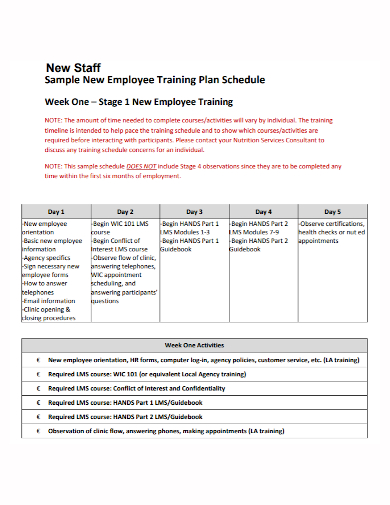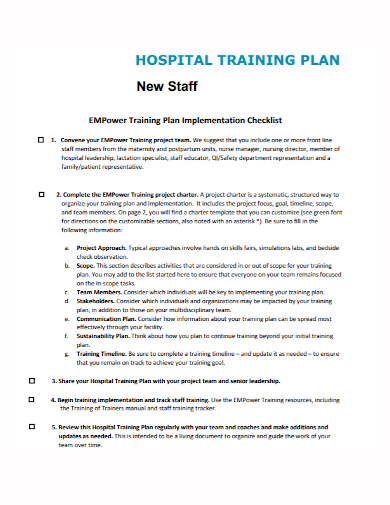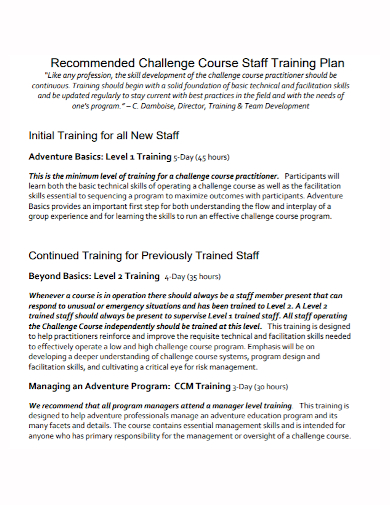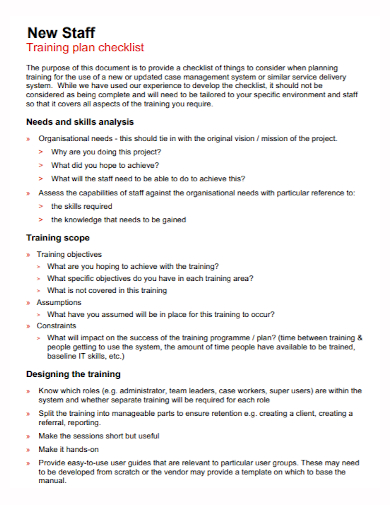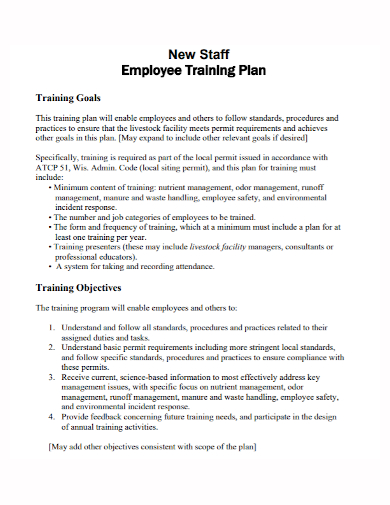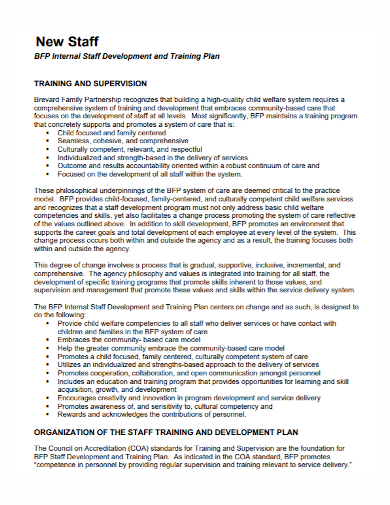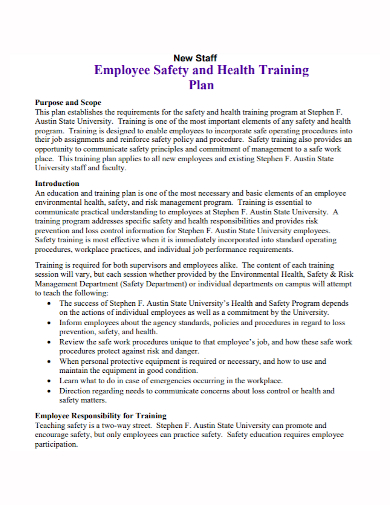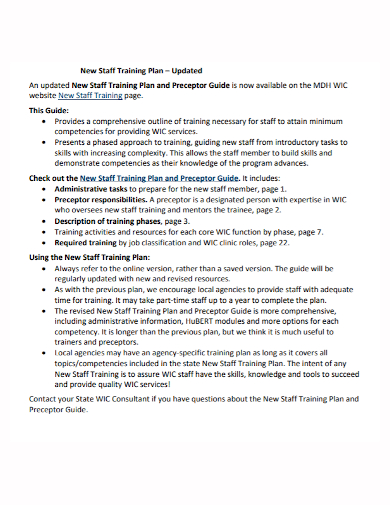I’d like you to recall your first job in the corporate world for a moment. Before you could get to your role-specific responsibilities, you probably had to go through a new hire onboarding program. Were you feeling ready? What aspects of the training program helped you be more effective in your job? You may not recall the details, but after a few job changes, you can probably attest to the level of preparedness you felt after attending various training programs. Every company recognizes the importance of a good training program. Employee training is widely acknowledged as a means of increasing efficiencies, lowering costs, and improving profit margins. However, there is a significant difference between an average staff training and development plan and one that will be effective.
10+ New Staff Training Plan Samples
Developing an effective and thorough employee training program is one of the best investments you’ll ever make for your company, thanks to the fact that effective employee training contributes to a low turnover rate. Not only will proper training make your new employees feel more at ease about starting their new job, but it will also provide them with the tools and resources they’ll need to succeed. Importantly, the right training will alert them to any policies or procedures they’ll need to follow to stay in compliance.
1. New Staff Training Plan Template

2. New Staff Development Training Plan
3. New Staff Employee Training Plan
4. New Staff Hospital Training Plan
5. New Course Staff Training Plan
6. New Staff Training Plan Checklist
7. Induction New Staff Training Plan
8. New Staff Goals Training Plan
9. Internal New Staff Training Plan
10. New Staff Safety and Health Training Plan
11. Sample New Staff Training Plan
Steps in Planning for New Staff Training
- Provide alternative teaching styles – It’s important to remember that different people learn in different ways whenever you’re teaching something. For instance, some people learn best by reading material from a book, while others learn best by listening to a lecture. Mix up how you teach your materials to ensure that you’re accommodating a variety of learning styles. Alternatively, if you have the resources, provide the materials both online and in-person so that your new hires can choose the format that best suits their learning style.
- Make a personal connection – Greeting new hires with open arms is one of the most effective ways to put them at ease. To put it another way, try to make your new employees’ training experience more personal by connecting with them right away. If you’re teaching your materials in person, one way to do this is to give everyone a few minutes to talk about themselves and what they hope to accomplish in their new position.
- Offer a lot of opportunities – Your new employees are likely to arrive at your training program with a lot of questions before they even begin. Most, if not all, of those questions, should be answered by the content of your training, but it’s not uncommon for employees to have more questions after everything is said and done. These questions can be beneficial because they may provide additional learning opportunities for everyone present.
- If possible, offer an online option – In addition to accommodating a variety of learning styles, providing online employee training has several advantages, the most important of which is convenience. Let’s say a new hire has given her current job a two-week notice period. Even though she won’t be able to start her new job right away, she will be able to complete the majority, if not all, of the required training during that time, ensuring that she is as prepared as possible on her first day. While we’re on the subject, new hires can get almost all of the busy work done before they start their new jobs if you put some of your onboarding and orientation materials online as well.
- Provide supplemental resources – Including as many supplemental resources as possible in your employee training program is always a good idea. If your employees must follow local or federal laws, for example, you may want to provide a book or a link to a website that explains those laws. Another example of supplemental training is an employee handbook, which will make your employees more accountable, capable, and prepared to do their best work while working for your company.
FAQs
What is onboarding?
Onboarding entails learning a lot about the company, the industry, the product, the customers, and the new tools. Onboarding can take up to a year in some companies with complex businesses. Layout an onboarding plan that is broken up into manageable pieces during the first few days of a new hire training program. A goal for the new hire should be included in each section of the onboarding process.
Why is it important to include the company history, mission, and vision?
It’s critical to provide company history, establishing a link between the past, present, and future so that new hires can understand the company’s direction. Explain who your customers and competitors are, as well as how your company differs from others in terms of vision, values, and short- and long-term objectives. When new employees have a better understanding of the company’s goals and priorities, they feel more connected and have a greater sense of purpose.
The more you do to assist your new employees in adjusting and feeling welcomed, the faster they will become productive members of your team. These suggestions will improve the training process and make it more appealing to new hires.
Related Posts
FREE 7+ Fashion Business Plan Samples in PDF
FREE 10+ Sprint Planning Samples In MS Word | Google Docs | PDF
FREE 10+ Wedding Planning Samples in MS Word | Apple Pages | Powerpoint | PDF
FREE 9+ Monthly Study Planner Samples in PSD | Illustrator | InDesign | PDF
FREE 9+ Sample Curriculum Planning Templates in PDF | MS Word
FREE 10+ Teacher Development Plan Samples in MS Word | Google Docs | Apple Pages | PDF
FREE 10+ Basketball Practice Plan Samples in PDF
FREE 12+ School Business Plan Samples in PDF | MS Word | Apple Pages | Google Docs
FREE 7+ Client Strategic Plan Samples in PDF | MS Word
FREE 11+ Trucking Business Plan Templates in PDF | MS Word | Google Docs | Pages
FREE 7+ Small Hotel Business Plan Samples PDF | MS Word | Apple Pages | Google Docs
FREE 14+ Bakery Business Plans in MS Word | PDF | Google Docs | Pages
FREE 4+ Yearly Lesson Plan Samples in PDF
FREE 50+ Strategic Planning Samples in Google Docs | Pages | PDF | MS Word
FREE 10+ Construction Project Plan Samples in MS Word | Google Docs | Apple Pages | PDF


